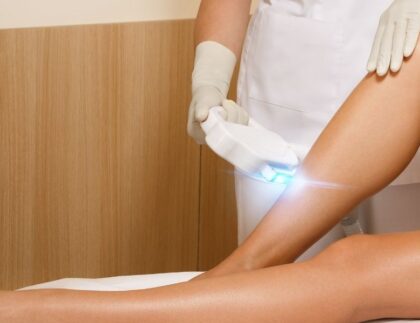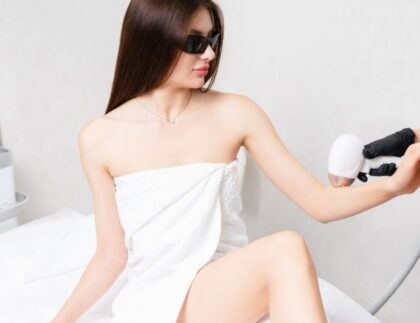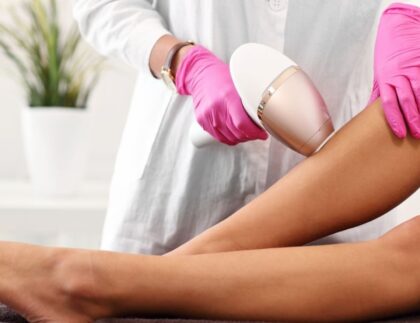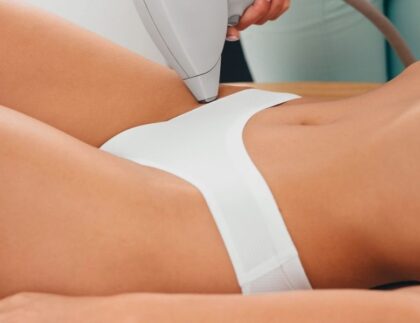Laser hair removal has become one of the most popular cosmetic treatments for achieving smooth, hair-free skin. But if you have tattoos or a tan, you might wonder whether it’s safe or effective for you. The truth is that your skin tone and tattoos can affect how laser energy interacts with your skin, making it important to understand what precautions and techniques professionals use. With proper care and the right technology, most people can still enjoy long-lasting results from laser hair removal in Annandale, VA, without compromising skin safety.
Laser hair removal works by directing concentrated light energy into the hair follicle, where pigment (melanin) absorbs the light and disables future growth. However, since both tattoos and tanned skin also contain pigment, this can make treatment more challenging. Understanding how modern laser systems distinguish between skin tone, tattoos, and hair color can help you make informed decisions about your treatment.
How Laser Hair Removal Works
Laser hair removal targets the pigment in hair follicles using controlled light pulses. The heat from the laser damages the follicle, inhibiting future growth while leaving the surrounding skin intact. For this process to work safely, the laser must accurately distinguish between the pigment in your hair and the pigment in your skin.
Older laser systems had difficulty treating darker or tanned skin tones because they couldn’t always differentiate between the two, increasing the risk of burns or pigmentation changes. Thankfully, advancements in laser technology now allow practitioners to customize settings to suit individual skin types safely.
Tattoos and Laser Hair Removal: Why Caution Is Key
If you have tattoos, you need to exercise extra care during laser hair removal. The pigment in tattoo ink absorbs laser energy just like hair pigment does. When a laser passes over tattooed skin, it can cause blistering, fading, or even burns. That’s why trained professionals avoid treating directly over tattoos.
Instead, practitioners will mark off tattooed areas and use protective barriers or specialized coverings to shield them during treatment. This prevents unwanted reactions and ensures your tattoo remains intact while the surrounding skin is treated safely. If you have large tattoos near the area you want treated, your provider may adjust the treatment zone to avoid direct contact with the ink.
Laser Hair Removal for Tan or Darker Skin Tones
Tanned and darker skin tones naturally contain more melanin, which can absorb laser energy intended for the hair follicle. This can sometimes cause irritation, redness, or hyperpigmentation if the wrong laser type or settings are used.
Modern laser systems, such as diode lasers, are designed to target hair follicles safely in a wide range of skin tones. These devices use longer wavelengths that bypass most of the melanin in the skin, focusing energy deeper where the follicle resides. Skilled technicians can further fine-tune these settings to reduce risks and improve comfort.
If you have a recent tan, whether from sun exposure or self-tanning products, it’s best to wait until your skin returns to its natural tone before scheduling your session. This allows for more precise targeting and minimizes side effects.
Preparing for Treatment
Proper preparation before laser hair removal makes a significant difference in safety and results. Avoid tanning, either naturally or artificially, for at least two weeks before your appointment. Shave the treatment area the day before so that the laser can focus on the follicle beneath the skin instead of surface hair.
You should also disclose any tattoos, recent sun exposure, or medications you’re taking to your provider. Some antibiotics and skincare ingredients like retinoids can make your skin more sensitive to light. Being honest about your skin’s condition allows the technician to customize your treatment safely.
What to Expect During and After Treatment
During your session, you may feel a slight snapping or warming sensation as the laser pulses across your skin. Tattooed areas will be avoided, and protective eyewear will be provided. Most treatments take between 15 and 60 minutes, depending on the size of the area.
After treatment, mild redness or swelling is normal and usually subsides within a few hours. Applying a cool compress and fragrance-free moisturizer can help soothe your skin. It’s also crucial to protect your skin from the sun with SPF 30 or higher, especially if you have tanned skin, to prevent irritation or pigment changes.
Is Laser Hair Removal Right for You?
Laser hair removal can be safe and effective for people with tattoos or tan skin when performed by experienced professionals using advanced technology. The key lies in selecting the right laser type, adjusting settings to your skin tone, and avoiding direct treatment over tattoos. With proper consultation and care, you can achieve smooth, long-term hair reduction without compromising your skin’s health.
Having tattoos or tanned skin doesn’t mean you have to miss out on the benefits of laser hair removal. The right approach, combined with modern laser technology and expert care, ensures your treatment is both safe and effective. Always choose a trusted clinic that tailors each session to your skin type and respects your unique needs. For professional and personalized laser hair removal in Annandale, VA, visit Denude to experience expert care that prioritizes your comfort and lasting results.
Laser hair removal has quickly become one of the most popular cosmetic treatments for smooth, long-lasting results. While it offers great benefits, the procedure leaves the skin temporarily sensitive. That’s why aftercare is so important, especially avoiding heat, friction, and products that can irritate the treated area. But what happens if you forget, and hop into the shower just an hour after your session? If you’ve found yourself in this situation, you’re not alone. Many people wonder whether a simple mistake could ruin their treatment or harm their skin.
Read moreLaser hair removal continues to be one of the most in-demand cosmetic procedures, and for good reason. It offers long-lasting results, reduced irritation, and freedom from constant maintenance routines. But not every part of the body responds equally to the treatment. The areas that show the best results tend to share certain characteristics like darker, coarser hair and lighter skin. Understanding which zones respond best helps people set clear expectations and choose treatment plans that deliver real results.
Read moreLaser hair removal is a popular and effective way to achieve long-term hair reduction. It’s especially common among active individuals who want to avoid constant shaving or waxing. But after a treatment session, one of the most common questions clients ask is: Can I still go to the gym?
Read moreIngrown hairs are a frustrating and often painful skin concern, especially for those with coarse or curly hair. Whether it’s from shaving, waxing, or plucking, the aftermath can lead to redness, bumps, and even infections. Over time, repeated hair removal can worsen the issue, causing inflammation and skin discoloration. People often search for long-term solutions to avoid the cycle of irritation, and one question continues to surface: Can laser hair removal get rid of ingrown hairs too?
Read moreDarkening along the bikini line is a common concern for many people, especially those who regularly shave, wax, or use hair removal creams. This discoloration, often caused by friction, irritation, and inflammation, can be frustrating. While it’s not a medical issue, hyperpigmentation can affect confidence, especially in warm months when swimsuits and summer wardrobes are part of daily life.
Read moreRemoving unwanted hair in delicate areas like the bikini line, underarms, and face is a common concern, especially for those with sensitive skin. Shaving, waxing, and tweezing can lead to irritation, ingrown hairs, and discomfort. Laser hair removal offers a longer-lasting solution, but many people wonder if it’s truly safe for sensitive regions of the body.
Read moreLaser hair removal is a convenient way to reduce unwanted hair, offering long-term results with minimal upkeep. However, proper aftercare is essential to protect your skin and ensure the best outcome. Without the right approach, you could experience irritation, redness, or even prolonged sensitivity. Whether you’re new to laser treatments or have had multiple sessions, knowing what to do—and what to avoid—after treatment makes a significant difference. If you’ve just undergone laser hair removal in Annandale, VA, follow these expert aftercare tips to keep your skin in top condition.
Read moreLaser hair removal is a popular method for long-term hair reduction, offering smooth skin without the hassle of shaving or waxing. While the treatment is safe and effective, proper aftercare is essential to ensure the best results and prevent irritation. Whether you’ve just had your first session or are in the middle of a treatment plan, correctly taking care of your skin can make a significant difference in your comfort and outcome. If you recently underwent laser hair removal in Vienna, VA, following these aftercare steps will help keep your skin healthy and irritation-free.
Read moreUnwanted hair can be frustrating to manage. These methods often feel like a never-ending cycle, from shaving and waxing to threading and plucking. If you’re looking for a way to cut back on the time and expense of traditional hair removal, laser hair removal is a long-term solution that can bring simplicity to your life. Not only does it reduce hair growth, but it also offers lasting value by saving both time and money over the years.
Read more








